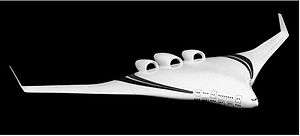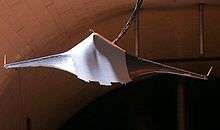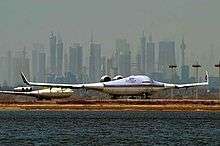Blended wing body


A blended wing body (BWB or Hybrid Wing Body, HWB[1]) is a fixed-wing aircraft having no clear dividing line between the wings and the main body of the craft. The form is composed of distinct wing and body structures, though the wings are smoothly blended into the body, unlike a flying wing which has no distinct fuselage.[2] A BWB design may or may not be tailless.
The potential advantages of the BWB approach are efficient high-lift wings and a wide airfoil-shaped body. This enables the entire craft to generate lift, potentially reducing the size and drag of the wings. A blended wing body can have a lift-to-drag ratio significantly greater than a conventional craft, offering improved fuel economy.
The BWB configuration is used for both aircraft and underwater gliders.
History
The 1924 Westland Dreadnought was built on the basis of the theories of M. Woyevodsky after wind tunnel tests. It stalled on its first flight, severely injuring the pilot, and the project was shelved by the British Air Ministry.
The Burnelli UB-14 was a 1930s American prototype lifting-fuselage airliner designed and built by Vincent Burnelli.
The Miles M.30 "X Minor" of the early 1940s was an experimental aircraft to test the blended wing fuselage design for a proposed large airliner, designated the Miles M.26. The McDonnell XP-67 prototype interceptor also flew in 1944 but did not come up to expectations.
NASA studied the concept more recently with a computer stabilized 17-foot model (6% scale) called BWB-17, built by Stanford University, which was flown in 1997 and showed good handling qualities.[3] From 2000 NASA went on to develop a remotely controlled model with a 21 ft (6.4 m) wingspan. This research is focused on establishing the base data concerning the lift, stall and spin characteristics inherent in a Blended Wing Body design.
NASA has also jointly explored BWB designs with the X-48 unmanned aerial vehicle.[4] Studies suggest that BWB aircraft, configured for passenger flight, could carry from 450 to 800 passengers and achieve fuel savings of over 20 percent.[5] Other suggestions are better access to emergency exits.[6] Unfortunately potential passengers disliked the internal seating arrangements and the program changed its focus toward cargo aircraft.
Characteristics

The BWB form minimises the total wetted area - the surface area of the aircraft skin, thus reducing skin drag to a minimum. It also creates a thickening of the wing root area, allowing a more efficient structure and reduced weight compared to a conventional craft. NASA also plans to integrate Ultra High Bypass (UHB) ratio jet engines with the hybrid wing body.[7]
The wide interior spaces created by the blending pose novel structural challenges. NASA has been studying foam-clad stitched-fabric carbon fiber composite skinning to create uninterrupted cabin space.[8]
A conventional tubular fuselage carries 12-13% of the total lift compared to 31-43% carried by the centerbody in a BWB, where an intermediate lifting-fuselage configuration better suited to narrowbody sized airliners would carry 25-32% for a 6.1% - 8.2% increase in fuel efficiency.[9]
Potential advantages
- Significant payload advantages in strategic airlift/air freight[10] and aerial refueling roles
- Increased fuel efficiency – 10.9% better than a conventional widebody[9]
- Lower noise – NASA audio simulations show a 15dB reduction of Boeing 777-class aircraft,[11] while other studies show 22–42 dB reduction below Stage 4 level depending on configuration.[1]
Potential disadvantages
- Evacuating a BWB in an emergency could be a challenge. Because of the aircraft's shape, the seating layout would be theatre-style instead of tubular. This imposes inherent limits on the number of exit doors.[12][13]
- In order to fully realise the potential advantages of the BWB design in a large aircraft, the engines are typically placed above the rear fuselage. Air safety authorities have expressed a concern that in an accident they could become detached and their momentum carry them forwards so that they fall onto the passenger cabin.
- Passengers are unwilling to sit in windowless environments.
- Passengers furthest from centerline will be subject to potential discomfort during wing roll. Extreme discomfort results in motion sickness.[14]
At an American Institute of Aeronautics and Astronautics meeting on March 28, 2018 at the University of Washington in Seattle, Boeing’s VP of Product Development and Future Airplane Development Mike Sinnett noted that as the center wingbox is also the passenger cabin, it needs to be tall enough to stand upright, translating into a large transport minimum span for multiple hundreds of passengers. For the same payload, a cargo BWB has more wingspan but is heavier empty and it is not worth it for short missions like four hours, while long haul routes benefit but the larger wing span conflicts with airport compatibility and containers quick loading: changing the infrastructure would need an over 20% improved new design except maybe for a military cargo aircraft. A tube-and-wing design is easier to stretch or shrink for several sub-types sharing the large development costs while a BWB can hardly be modified by its most expensive non-constant section in a non-constant way.[15]
List of blended wing body aircraft
| Type | Country | Class | Role | Date | Status | Notes |
|---|---|---|---|---|---|---|
| AVIC 601-S | China | UAV | Tailless. Series of variants. | |||
| Boeing X-45C | US | UAV | 2002 | |||
| Boeing X-48 | US | 2007 | ||||
| Dassault nEUROn | FR | UAV | 2012 | Tailless | ||
| Lockheed Martin RQ-3 DarkStar | US | UAV | 1996 | |||
| Lockheed Martin RQ-170 Sentinel | US | UAV | 2007 | Tailless | ||
| McDonnell XP-67 | US | Propeller | Fighter | 1944 | Prototype | Twin propellers. Maintained aerofoil profile throughout. |
| Miles M.30 | UK | Research | 1942 | Prototype | ||
| Northrop Grumman X-47 Pegasus | US | UAV | 2003 | |||
| Gothaer Waggonfabrik Horten Ho 229 | DE | Jet Engines | Fighter/Bomber | 1944 | Prototype | |
| Stout Batwing | UK | propeller | fighter/bomber | 1918 | ||
| Westland Dreadnought | UK | Propeller | Transport | 1924 | Prototype | Mailplane. |
In popular culture
Popular Science concept

A concept photo of a blended wing body commercial aircraft appeared in the November 2003 issue of Popular Science magazine.[16] Artists Neill Blomkamp and Simon van de Lagemaat from The Embassy Visual Effects created the photo for the magazine using computer graphics software to depict the future of aviation and air travel.[17] The BWB-450, a pre-X-48 concept from the late 1990s, or the X-48A concept from around 2001[18] may have inspired the photo. The image was subsequently used in emails since 2006 claiming that Boeing has developed a "1000 passenger Jet Liner" (the "Boeing 797") with a "radical Blended Wing design" in direct competition to the Airbus A380. Boeing denied the claim at the time.[19][20]
See also
- List of flying wings
- Lifting body
- Silent Aircraft Initiative, a BWB study
References
Notes
- 1 2 Russell H. Thomas, Casey L. Burley and Erik D. Olson (2010). "Hybrid Wing Body Aircraft System Noise Assessment With Propulsion Airframe Aeroacoustic Experiments" (PDF). Retrieved 26 January 2013. Presentation Archived 2013-05-16 at the Wayback Machine.
- ↑ Crane 1997, p. 224.
- ↑ Liebeck 2004, p. 16.
- ↑ "A flight toward the future." Archived December 4, 2012, at the Wayback Machine. Boeing, August 7, 2012 Retrieved: November 23, 2012.
- ↑ Liebeck 2004, p. 21.
- ↑ Liebeck 2004, p. 24.
- ↑ Michael Braukus / Kathy Barnstorff (Jan 7, 2013). "NASA's Green Aviation Research Throttles Up Into Second Gear". NASA. Retrieved Jan 26, 2013.
- ↑ Bullis, Kevin (January 24, 2013). "NASA has demonstrated a manufacturing breakthrough that will allow hybrid wing aircraft to be scaled up". MIT Technology Review.
- 1 2 Graham Warwick (Aug 22, 2016). "Finding Ultra-Efficient Designs For Smaller Airliners". Aviation Week & Space Technology.
- ↑ Warwick, Graham. "Boeing works with airlines on commercial blended wing body freighter." Flight International, May 21, 2007.
- ↑ Warwick, Graham (Jan 12, 2013). "Hear This - The BWB is Quiet!". Aviation Week.
- ↑ E. R. Galea; L. Filippidis; Z. Wang; P. J. Lawrence; J. Ewer (2011). "Evacuation Analysis of 1000+ Seat Blended Wing Body Aircraft Configurations: Computer Simulations and Full-scale Evacuation Experiment". Pedestrian and Evacuation Dynamics. pp. 151&ndash, 61. doi:10.1007/978-1-4419-9725-8_14. ISBN 978-1-4419-9724-1.
- ↑ Galea, Ed. "Evacuation analysis of 1000+ seat Blended Wing Body aircraft configurations". evacmod.net (video). Retrieved August 25, 2015.
- ↑ "Boeing not convinced by blended wing aircraft design". Institution of Mechanical Engineers. June 16, 2015.
- ↑ "Don't look for commercial BWB airplane any time soon, says Boeing's future airplanes head". Leeham News. April 3, 2018.
- ↑ "Future of Flight." Popular Science, November 2003.
- ↑ "Future Flight: A Gallery of the Next Century in Aviation." PopSci.com, October 15, 2003. Retrieved: November 22, 2012.
- ↑ Chambers, Joseph R. NASA SP-2005-4539 "Innovation In Flight: Research Of The NASA Langley Research Center On Revolutionary Advanced Concepts For Aeronautics". NASA, August 22, 2005.
- ↑ Christensen, Brett M. "Boeing 797 Hoax" Hoax-Slayer, April 19, 2012. Retrieved: November 22, 2012.
- ↑ Baseler, Randy. "Air mail." Boeing blogs: Randy's Journal, November 1, 2006. Retrieved: November 22, 2012.
Bibliography
- Crane, Dale. Dictionary of Aeronautical Terms, third edition. Newcastle, Washington: Aviation Supplies & Academics, 1997. ISBN 1-56027-287-2.
- Herwig, Dieter and Heinz Rode. Luftwaffe Secret Projects: Strategic Bombers 1935–1945. Hinckley, UK: Midland, 2000. ISBN 978-1-85780-092-0.
- Liebeck, R.H. "Design of the Blended Wing Body Subsonic Transport." AIAA Journal of Aircraft, Volume 41, Issue 1, January–February 2004, pp. 10–25.
- Rose, Bill. Secret Projects: Flying Wings and Tailless Aircraft. Hinckley, UK: Midland Publishing, 2010. ISBN 978-1-85780-320-4.
External links
- NASA's X-48B/Blended Wing Body page
- 'Blended wing' craft passes wind-tunnel tests," NewScientist.com news service, 14 November 2005
- How design of SAX-40 aircraft reduces noise and improve efficiency
- Progress on the Wingco Atlantica small BWB plane
- Airliners.net photo of the Atlantica prototype aircraft, July 2004
- "Truth Or Fiction" on the rumour of the Boeing 797 blended wing passenger liner
- Blended Wing Body, HAW Hamburg
- Photo-realistic image of blended wing airliner taxiing at airport
- A Blended Wing Body concept by Cranfield University
- NASA Facts - The Blended-Wing-Body
- Blended-wing-body: Design challenges for the 21st century